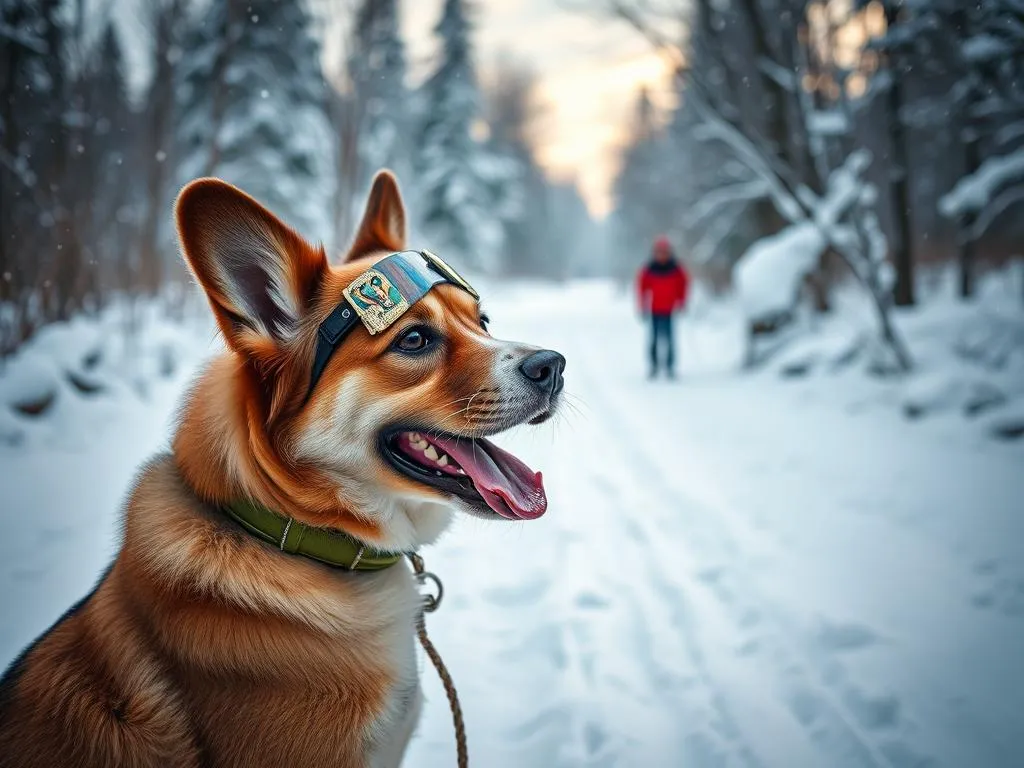
Winter can be a magical time for dogs and their owners, transforming ordinary walks into exhilarating adventures. Engaging in dog winter sports activities not only keeps dogs active but also strengthens the bond between pets and their humans. As the snow blankets the ground, there are countless opportunities for fun, exercise, and exploration. This article will dive into the various types of winter sports for dogs, tips for preparation and safety, and the many benefits these activities offer.
Understanding Dog Winter Sports
Definition of Winter Sports for Dogs
Dog winter sports activities encompass a variety of outdoor pursuits where dogs are actively involved in the fun. From dog sledding to snowshoeing, these activities leverage the unique capabilities of dogs in winter environments. Historically, dogs have played essential roles in winter sports, from aiding in transportation in Arctic regions to competing in exciting canine events.
Benefits of Winter Sports for Dogs
There are numerous benefits to involving your dog in winter sports:
- Physical Health: Engaging in these activities provides essential exercise, helping to manage weight and improve overall fitness.
- Mental Stimulation: Winter sports combat boredom and stimulate dogs mentally, which is crucial during the colder months when outdoor activities may be limited.
- Strengthened Bond: Participating in winter sports fosters a deeper connection between dog and owner as you work together towards goals and enjoy shared experiences.
Popular Winter Sports Activities for Dogs
Dog Sledding
One of the most iconic dog winter sports activities is dog sledding. This exhilarating sport involves a team of dogs pulling a sled through snow-covered trails. Breeds such as Siberian Huskies, Alaskan Malamutes, and Samoyeds are particularly well-suited for this sport due to their strength and endurance.
Training Tips for Dog Sledding:
– Start with basic obedience training to ensure your dog understands commands.
– Gradually introduce your dog to the sled and harness, allowing them to adjust before taking them out on the trails.
– Practice running short distances before extending to longer sledding sessions.
Skijoring
Skijoring is another exciting option that combines skiing and dog power. In this sport, a skier is pulled by one or more dogs, creating a thrilling experience for both parties.
Equipment Needed:
– A skijoring belt that attaches to the skier.
– A harness for your dog that distributes weight evenly.
– A leash that is specifically designed for skijoring, allowing for some elasticity.
Best Practices for Beginners:
– Start with a well-trained dog who is familiar with commands.
– Choose flat, groomed trails for your first attempts, gradually increasing the difficulty as you both gain confidence.
– Always prioritize safety by ensuring your dog is comfortable with the activity.
Snowshoeing with Dogs
Snowshoeing is a fantastic way to explore the winter landscape with your dog. This activity allows you to traverse snowy trails while your dog enjoys the freedom to roam and play.
Recommended Trails and Locations:
– National parks often have designated snowshoeing trails that are dog-friendly.
– Local parks may also have well-maintained paths suitable for snowshoeing.
Gear for Snowshoeing:
– Invest in good quality snowshoes for yourself.
– Ensure your dog has a warm coat and booties to protect their paws from the cold and sharp ice.
Winter Hiking
Winter hiking offers a unique way to experience nature with your dog. It’s essential to know how to keep your furry friend safe and comfortable during these excursions.
Tips for Safe Winter Hiking:
– Choose trails that are well-marked and maintained, avoiding steep or treacherous terrain.
– Keep your dog leashed to ensure their safety and the safety of wildlife.
Best Winter Hiking Trails:
– Look for regional hiking guides that highlight dog-friendly winter trails.
– Many state parks have winter hiking programs that cater to pet owners.
Essential Gear for Winter Hiking:
– Layered clothing for yourself to stay warm and dry.
– A first-aid kit for both you and your dog in case of emergencies.
Canine Freestyle or Dog Dancing
Canine freestyle, often referred to as dog dancing, is not only a winter sport but an art form. This creative activity involves choreographed routines performed by dogs and their owners, often set to music.
Training Tips and Tricks:
– Start with basic obedience commands and gradually introduce more complex tricks.
– Use positive reinforcement to encourage your dog to learn new moves.
Benefits of Dance for Dogs and Owners:
– Enhances the physical fitness of both dog and owner.
– Strengthens communication and teamwork skills.
Snow Agility
Another thrilling option is snow agility, which combines agility training with a snowy environment. This sport involves navigating an obstacle course set up in the snow.
Setting Up a Winter Agility Course:
– Use items like cones, tunnels, and jumps that are visible in the snow.
– Ensure the course is safe and accessible, avoiding icy patches.
Training Your Dog for Agility in Snowy Conditions:
– Start with basic agility training in a warmer season before transitioning to snow.
– Utilize positive reinforcement techniques to keep your dog engaged and motivated.
Preparing Your Dog for Winter Sports
Assessing Your Dog’s Fitness Level
Before embarking on any dog winter sports activities, it’s crucial to assess your dog’s fitness level. A visit to the vet can help determine if your dog is healthy enough for rigorous exercise in cold weather.
Signs Your Dog is Ready for Winter Sports:
– Your dog shows excitement and interest in outdoor activities.
– They have been regularly exercised and are in good physical condition.
Proper Conditioning and Training
Conditioning your dog for winter sports is essential for preventing injury and ensuring they can keep up with the activities.
Conditioning Exercises:
– Gradual increases in activity levels over time.
– Incorporate strength-building exercises such as hill climbs and short sprints during walks.
Training Tips Specific to Each Winter Activity:
– Tailor your training sessions to the specific sport you plan to engage in, focusing on relevant skills and commands.
Gear and Equipment for Dogs
Ensuring your dog has the right gear for winter sports is vital for their comfort and safety.
Essential Winter Gear for Dogs:
– Coats: A well-fitted, insulated coat can help keep your dog warm.
– Booties: Protects paws from cold, ice, and salt used on roads and trails.
– Reflective gear: Increases visibility during winter outings.
Safety Tips for Winter Sports
Weather Considerations
When planning dog winter sports activities, weather conditions play a crucial role in safety.
Identifying Safe Temperature Ranges:
– Generally, temperatures above 20°F (-6°C) are safe for most dogs, but this can vary depending on breed and acclimatization.
Monitoring Weather Conditions:
– Keep an eye on wind chill factors and snow depth, which can impact safety during outdoor activities.
Hydration and Nutrition
It’s easy to overlook hydration during winter, but it’s just as important in cold weather.
Importance of Keeping Dogs Hydrated:
– Always bring water along on trips and take breaks for your dog to hydrate.
Nutritional Needs for Active Dogs in Cold Climates:
– Consider increasing your dog’s caloric intake during active winter months to support their energy needs.
Recognizing Signs of Cold Stress
Being vigilant about your dog’s well-being is essential during winter sports.
Common Symptoms of Hypothermia and Frostbite:
– Shivering, lethargy, or whining can indicate cold stress.
– Check paws for signs of frostbite, such as discoloration or swelling.
What to Do if Your Dog Shows Signs of Distress:
– Bring them indoors to warm up gradually.
– Wrap them in a blanket and provide warmth until they seem comfortable again.
Finding Dog-Friendly Winter Sports Locations
Local Parks and Trails
Finding suitable locations for dog winter sports activities is key to having enjoyable outings.
How to Find Nearby Dog-Friendly Parks:
– Use local park websites or apps that highlight dog-friendly trails and amenities.
Tips for Respecting Park Rules and Regulations:
– Always keep your dog leashed unless in designated off-leash areas.
– Clean up after your pet to maintain a safe and pleasant environment for all.
Dog Sledding and Skijoring Clubs
Joining a community can enhance your winter sports experience.
Resources for Locating Clubs and Groups:
– Search online for local dog sledding or skijoring clubs where you can meet other enthusiasts and learn from experienced members.
Benefits of Joining a Local Dog Sports Community:
– Gain access to training resources, events, and competitions.
– Form friendships with fellow dog lovers who share similar interests.
Events and Competitions
Participating in or spectating at winter sports competitions can be a thrilling experience.
Overview of Winter Sports Competitions for Dogs:
– Various events are held throughout the winter, including dog sled races and agility competitions.
How to Participate or Spectate at Local Events:
– Check local event calendars and social media for updates on competitions in your area.
Conclusion
Engaging in dog winter sports activities offers a myriad of benefits, from physical fitness to deepening the bond with your furry friend. The cold season need not be a time of inactivity; rather, it can be an opportunity for exploration and fun. By trying out new activities, you and your dog can enjoy the beauty of winter together while staying healthy and happy. So lace up those boots, grab your gear, and head outdoors to create unforgettable winter memories with your beloved pet!









